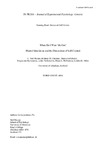When do I wear me out? Mental simulation and the diminution of self-control.
| dc.contributor.author | Macrae, CN | en |
| dc.contributor.author | Christian, BM | en |
| dc.contributor.author | Golubickis, M | en |
| dc.contributor.author | Karanasiou, M | en |
| dc.contributor.author | Troksiarova, L | en |
| dc.contributor.author | McNamara, DL | en |
| dc.contributor.author | Miles, LK | en |
| dc.date.accessioned | 2020-04-07T12:28:41Z | |
| dc.date.available | 2020-04-07T12:28:41Z | |
| dc.date.issued | 2014-08 | en |
| dc.identifier.uri | http://hdl.handle.net/10026.1/15536 | |
| dc.description.abstract |
Exerting self-control can diminish people's capacity to engage in subsequent acts of behavioral regulation, a phenomenon termed ego depletion. But what of imaginary regulatory experiences-does simulated restraint elicit comparable lapses in self-control? Here we demonstrate such effects under theoretically tractable imagery conditions. Across 3 experiments, temporal, structural, and spatial components of mental simulation were observed to drive the efficacy of imaginary self-control. In Experiment 1, lapses in restraint (i.e., financial impulsivity) were more pronounced when imaginary regulation (i.e., dietary restraint) focused on an event in the near versus distant future. In Experiment 2, comparable effects (i.e., increased stereotyping) emerged when simulated self-control (i.e., emotional suppression) was imagined from a first-person (cf. third-person) visual perspective. In Experiment 3, restraint was diminished (i.e., increased risk taking) when self-regulation (i.e., action control) centered on an event at a near versus distant location. These findings further delineate the conditions under which mental simulation impacts core aspects of social-cognitive functioning. | en |
| dc.format.extent | 1755 - 1764 | en |
| dc.language | eng | en |
| dc.language.iso | eng | en |
| dc.subject | Cognition | en |
| dc.subject | Ego | en |
| dc.subject | Female | en |
| dc.subject | Humans | en |
| dc.subject | Male | en |
| dc.subject | Risk-Taking | en |
| dc.subject | Social Control, Informal | en |
| dc.subject | Time Factors | en |
| dc.title | When do I wear me out? Mental simulation and the diminution of self-control. | en |
| dc.type | Journal Article | |
| plymouth.author-url | https://www.ncbi.nlm.nih.gov/pubmed/24635189 | en |
| plymouth.issue | 4 | en |
| plymouth.volume | 143 | en |
| plymouth.publication-status | Published | en |
| plymouth.journal | J Exp Psychol Gen | en |
| dc.identifier.doi | 10.1037/a0036100 | en |
| plymouth.organisational-group | /Plymouth | |
| plymouth.organisational-group | /Plymouth/Faculty of Health | |
| plymouth.organisational-group | /Plymouth/Faculty of Health/School of Psychology | |
| plymouth.organisational-group | /Plymouth/REF 2021 Researchers by UoA | |
| plymouth.organisational-group | /Plymouth/REF 2021 Researchers by UoA/UoA04 Psychology, Psychiatry and Neuroscience | |
| plymouth.organisational-group | /Plymouth/REF 2021 Researchers by UoA/UoA04 Psychology, Psychiatry and Neuroscience/UoA04 Psychology, Psychiatry and Neuroscience MANUAL | |
| plymouth.organisational-group | /Plymouth/Users by role | |
| plymouth.organisational-group | /Plymouth/Users by role/Academics | |
| dc.publisher.place | United States | en |
| dc.identifier.eissn | 1939-2222 | en |
| dc.rights.embargoperiod | Not known | en |
| rioxxterms.versionofrecord | 10.1037/a0036100 | en |
| rioxxterms.licenseref.uri | http://www.rioxx.net/licenses/all-rights-reserved | en |
| rioxxterms.type | Journal Article/Review | en |


